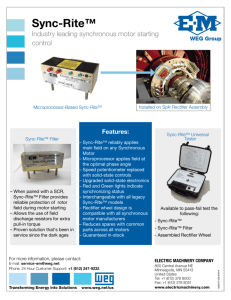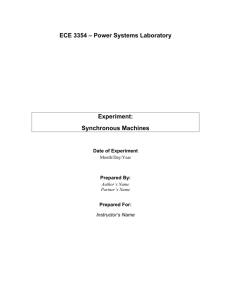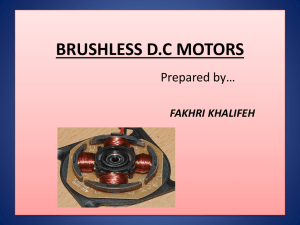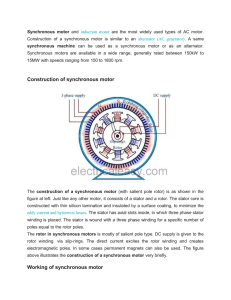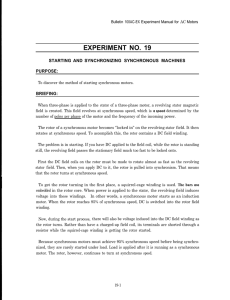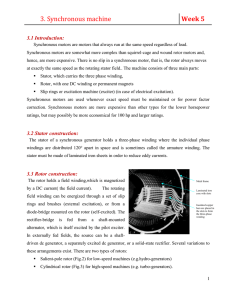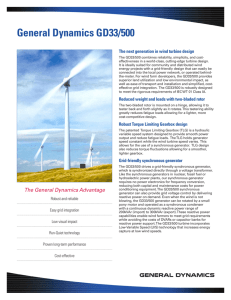practical work EEC233 week 03 - Unesco
advertisement
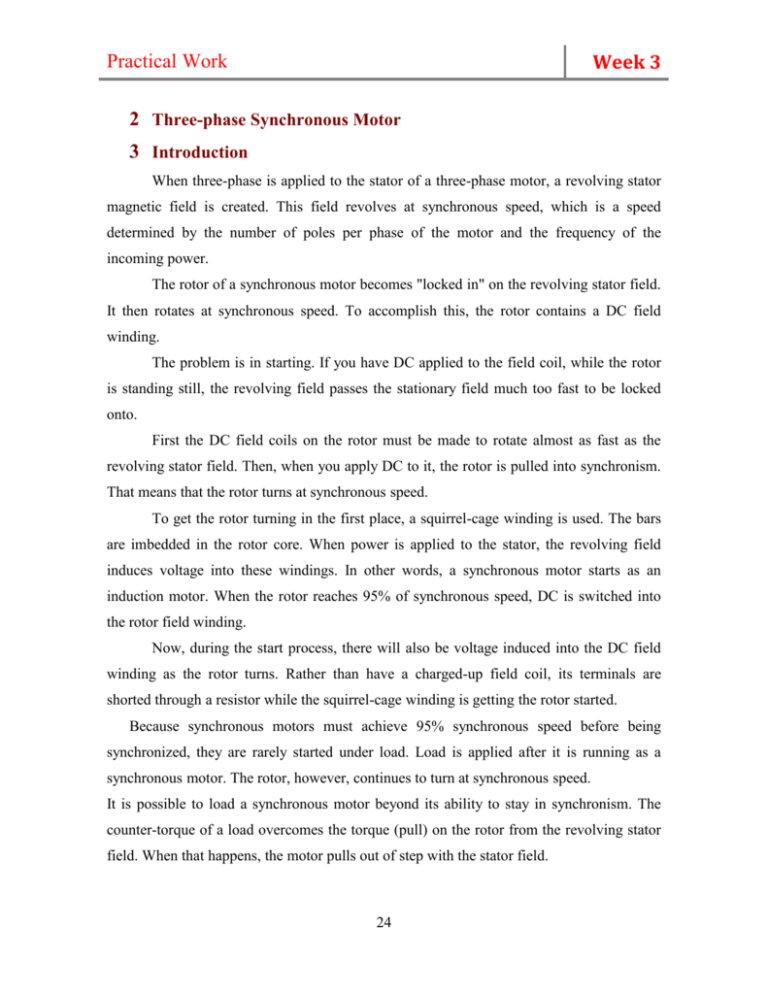
Week 3 Practical Work 2 Three-phase Synchronous Motor 3 Introduction When three-phase is applied to the stator of a three-phase motor, a revolving stator magnetic field is created. This field revolves at synchronous speed, which is a speed determined by the number of poles per phase of the motor and the frequency of the incoming power. The rotor of a synchronous motor becomes "locked in" on the revolving stator field. It then rotates at synchronous speed. To accomplish this, the rotor contains a DC field winding. The problem is in starting. If you have DC applied to the field coil, while the rotor is standing still, the revolving field passes the stationary field much too fast to be locked onto. First the DC field coils on the rotor must be made to rotate almost as fast as the revolving stator field. Then, when you apply DC to it, the rotor is pulled into synchronism. That means that the rotor turns at synchronous speed. To get the rotor turning in the first place, a squirrel-cage winding is used. The bars are imbedded in the rotor core. When power is applied to the stator, the revolving field induces voltage into these windings. In other words, a synchronous motor starts as an induction motor. When the rotor reaches 95% of synchronous speed, DC is switched into the rotor field winding. Now, during the start process, there will also be voltage induced into the DC field winding as the rotor turns. Rather than have a charged-up field coil, its terminals are shorted through a resistor while the squirrel-cage winding is getting the rotor started. Because synchronous motors must achieve 95% synchronous speed before being synchronized, they are rarely started under load. Load is applied after it is running as a synchronous motor. The rotor, however, continues to turn at synchronous speed. It is possible to load a synchronous motor beyond its ability to stay in synchronism. The counter-torque of a load overcomes the torque (pull) on the rotor from the revolving stator field. When that happens, the motor pulls out of step with the stator field. 24 Week 3 Practical Work It will not simply fall back to running smoothly as an induction motor, however. Induced currents, added to the excitation current in the DC field winding, make the rotor pulsate. Therefore, field excitation should be removed as soon as possible after the rotor pulls out of synchronism. Then, if you want to re-synchronize the motor, you must first remove the overload. The speed of the synchronous motor stays constant under load. However when the load increases, we notice: a) That the line current increase. b) That the speed changes momentarily during load changes. c) That the motor can fall out of synchronism if the load is higher than twice the rated capacity. Torque – Speed Characteristic Apparatus 1. One synchronous machine 2. One power supply 3. One Prony Brake 4. One AC instrumentation group 5. One DC instrumentation group 6. One tachometer Procedure : 1. Couple the Prony Brake to the synchronous motor. 2. Connect the circuit shown in figure 2-1 25 Week 3 Practical Work Prony brake L1 A Tach U1 L2 V1 Supply 3Ø 0-415V Ac 0-1A dc U2 A V2 V + Supply 0-250V dc _ W2 W1 L3 Figure (2-1) 3. Start the motor and make sure its rotation is in the "right direction for the scale of the Prony brake. 4. Adjust the field rheostat for nominal speed . 5. Load the motor by prony brake in five steps to 125% of rated capacity. 6. Record your readings in Table 4-1 for each step. 7. Turn off the power supply. Torque (T) Speed (N) (N.m) (RPM) 0 26 Week 3 Practical Work Worksheet 03 Solve the following questions: 1. Connect the circuit as shown in figure (2-1), Operate, record your results in Table 2-1 and plot the graph of motor speed versus applied torque (T VS N) Table(2-1) Graph 2-1 27

